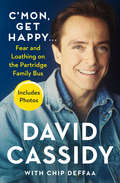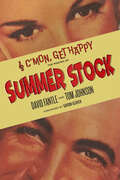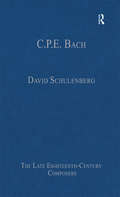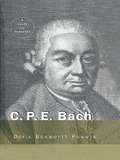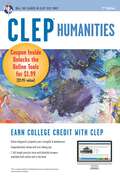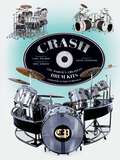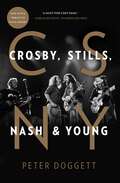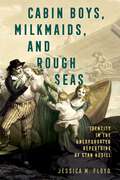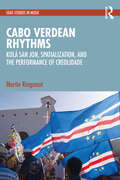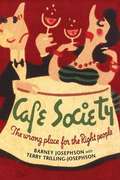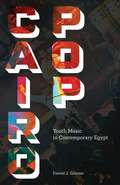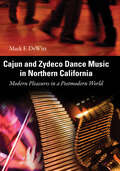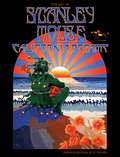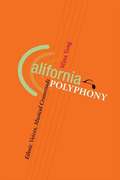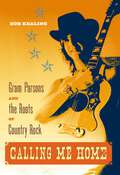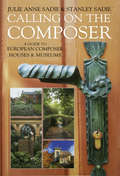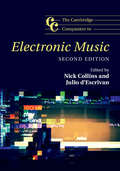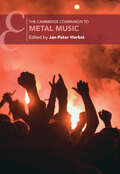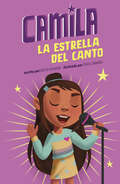- Table View
- List View
C'mon, Get Happy . . .: Fear and Loathing on the Partridge Family Bus
by David Cassidy Chip DeffaaThis memoir by David Cassidy tells the real story behind his phenomenal ’70s stardom—and the sadness that shadowed it. Includes photos and a new afterword. Barely out of his teens, David Cassidy landed a role on a new sitcom about a musical family that toured in a psychedelic bus. The critics blasted it—but TV viewers loved it! And the young female audience especially loved Keith Partridge. Not only did they tune in each week, they bought The Partridge Family’s hit single, “I Think I Love You,” in the millions, and plastered David’s image on their bedroom walls. Throughout the early seventies, David Cassidy was a phenomenon. In this wry, witty memoir, he recounts not only those wild youthful years and Hollywood relationships—with, among others, stepmom Shirley Jones, costar Susan Dey, actress Meredith Baxter, and two guest stars who soon found greater fame on Charlie’s Angels—but also the darker parts of his life as well. David delves into his painful family history and his childhood in West Orange, New Jersey, and the groupies and drugs he indulged in as his success began to overwhelm him. He also shares his encounters with the icons of the era—Lennon and McCartney, Elvis, the Beach Boys, and more. Most of all, he takes us back to a time when the world seemed more innocent—at least until the camera stopped rolling. Includes a new afterword about David’s final years by friend and coauthor Chip Deffaa. “A chatty read about becoming an overnight success and all the trappings that came with it: Tiger Beat magazine, sold-out stadium shows, hit records, willing girls in every hotel lobby.” —Star Tribune
C'mon, Get Happy: The Making of Summer Stock
by Tom Johnson David FantleIn their third and final screen teaming, Judy Garland and Gene Kelly starred together in the MGM musical Summer Stock. Despite its riveting production history, charismatic lead actors, and classic musical moments, the movie has not received the same attention as other musicals from MGM’s storied dream factory. In C’mon, Get Happy: The Making of “Summer Stock,” authors David Fantle and Tom Johnson present a comprehensive study of this 1950 motion picture, from start to finish and after its release.The production coincided at a critical point in the careers of Kelly and an emotionally spent Garland. Kelly, who starred in An American in Paris just one year later, was at the peak of his abilities. On the other hand, Summer Stock was Garland’s final film at MGM, and she gamely completed it despite her own personal struggles. Summer Stock includes Kelly’s favorite solo dance routine and Garland’s signature number “Get Happy.”The authors discuss in rich detail the contributions of the cast (which included Gloria DeHaven, Eddie Bracken, Phil Silvers, and Marjorie Main); the director (Charles Walters); the producer (Joe Pasternak); the script writers (George Wells and Sy Gomberg); the songwriters (which included Harry Warren and Mack Gordon); and top MGM executives (Louis B. Mayer and Dore Schary). The volume features extensive interviews, conducted by the authors, with Kelly, Walters, Warren, and others, who shared their recollections of making the movie. Deeply researched, C’mon, Get Happy reveals the studio system at work during Hollywood’s Golden Era.Additionally, the authors have written a special section called “Taking Stock” that buttonholes numerous contemporary dancers, singers, choreographers, musicians, and even Garland impersonators for their take on Summer Stock, its stars, and any enduring legacy they think the film might have. Artists from Mikhail Baryshnikov, Ben Vereen, and Tommy Tune to Garland’s and Kelly’s daughters, Lorna Luft and Kerry Kelly Novick, respectively, offer their unique perspective on the film and its stars.
C.P.E. Bach (The\late Eighteenth-century Composers Ser.)
by David SchulenbergThe second son of Johann Sebastian Bach, C.P.E. Bach was an important composer in his own right, as well as a writer and performer on keyboard instruments. He composed roughly a thousand works in all the leading genres of the period, with the exception of opera, and Haydn, Mozart and Beethoven all acknowledged his influence. He was also the author of a two-volume encyclopedic book about performance on keyboard instrument. C.P.E. Bach and his music have always been the subject of significant scholarship and publication but interest has sharply increased over the past two or three decades from performers as well as music historians. This volume incorporates important writings not only on the composer and his chief works but also on theoretical issues and performance questions. The focus throughout is on relatively recent scholarship otherwise available only in hard-to-access sources.
C.P.E. Bach: A Guide to Research (Routledge Music Bibliographies)
by Doris PowersAlthough he is the son of J. S. Bach, C. P. E. Bach is an important composer in his own right, this long-awaited annotated bibliography presents a complete listing of the works of C. P. E. Bach. This volume in the Routledge Music Bibliographies series includes many different aspects of his work: the editing of his father's masterpieces, his concert
CLEP® Humanities Book + Online (CLEP Test Preparation)
by Robert Liftig Marguerite BarrettEarn College Credit with REA’s Test Prep for CLEP Humanities Everything you need to pass the exam and get the college credit you deserve. REA leads the way in helping students pass their College Board CLEP exams and earn college credit while reducing their tuition costs. With 25+ years of experience in test prep for the College-Level Examination Program (CLEP), REA is your trusted source for the most up-to-date test-aligned content. Whether you’re an adult returning to finish your degree, a traditional-age college student, a military service member, or a high school or home-schooled student looking to get a head start on college and shorten your path to graduation, CLEP is perfect for you. REA’s expert authors know the CLEP tests inside out. And thanks to our partners at Proctortrack (proctortrack.com/clep), you can now take your exam at your convenience, from the comfort of home. Prep for success on the CLEP Humanities exam with REA’s personalized three-step plan: (1) focus your study, (2) review with the book, and (3) measure your test-readiness. Our Book + Online prep gives you all the tools you need to make the most of your study time: Diagnostic exam: Pinpoint what you already know and what you need to study.Targeted subject review: Learn what you’ll be tested on.Two full-length practice exams: Zero in on the topics that give you trouble now so you’ll be confident and prepared on test day.Glossary of key terms: Round out your prep with must-know vocabulary.REA is America’s recognized leader in CLEP preparation. Our test prep helps you earn valuable college credit, save on tuition, and accelerate your path to a college degree.
CRASH: The World's Greatest Drum Kits From Appice to Peart to Van Halen
by David FrangioniFrom snares to cymbals, drums are taking over the stage in this first-ever collected look into some of the most famous drum kits of rock and roll history. Crash is the definitive Illustrated history of the drum kits of rock &’n&’ roll legends. Featuring images from live concerts, outdoor festivals, and private recording sessions, this spectacular volume captures the personal connection between artist and instrument. Along with the makes and models, each kit is accompanied by commentary about the history of the kit, its special characteristics, as well as its significance to rock history. Including photographs of Neil Peart, Carl Palmer, Ginger Baker, Keith Moon, Ringo Starr, and many more, Crash is the ultimate photographic guide to the world of rock &’n&’ roll&’s most famous drum kits.
CSNY: Crosby, Stills, Nash and Young
by Peter DoggettAn engaging and illuminating biography focused on the formative and highly influential early years of &“rock&’s first supergroup&” (Rolling Stone) Crosby, Stills, Nash, and Young—when they were the most successful, influential, and politically potent band in America.After making their marks in popular bands such as the Hollies and the Byrds, David Crosby, Stephen Stills, and Graham Nash released their first album in May 1969. By the time they arrived at Woodstock a few months later, Neil Young had joined their ranks and together, their transcendent harmonies and evocative lyrics channeled all the romantic idealism and radical angst of their time. Now, music journalist Peter Doggett chronicles these legendary musicians and the movement they came to represent at the height of their popularity and influence: 1969 to 1974. Based on interviews with the band and colleagues, along with exclusive access to CSNY&’s archive, Doggett provides new insights into their incredible catalog, from their delicate acoustic confessionals like &“Suite: Judy Blue Eyes&” to their timeless classics such as &“Our House.&” Doggett also uncovers plenty of new stories and perspectives on the four tenacious and volatile songwriters&’ infamously reckless, hedonistic, and often combative lifestyles that led to their continuous breakups and behaviors—extreme even by rock star standards. &“A must for CSNY fans and anyone who remembers the era when it ruled the pop charts&” (Kirkus Reviews, starred review), CSNY is a quintessential and definitive account of one of the biggest bands of the Woodstock generation.
Cabin Boys, Milkmaids, and Rough Seas: Identity in the Unexpurgated Repertoire of Stan Hugill
by Jessica M. FloydDuring his correspondence with erotic folklore collector Gershon Legman, famed chantey singer and collector Stan Hugill (1906–1992) shared unexpurgated versions of the songs in his repertoire. These bawdy songs were meant to be a part of Legman’s larger project concerning erotic folksong. Upon Legman’s death in 1999, the unfinished and unpublished manuscript sank into obscurity and was believed by many to be permanently lost. Thankfully this “holy grail” of chantey texts had been safe in the private collection of Legman’s widow, Judith Legman, all along. Cabin Boys, Milkmaids, and Rough Seas: Identity in the Unexpurgated Repertoire of Stan Hugill is the first critical investigation of this repository, reproduced here for the first time. Training an interdisciplinary lens on twenty-four unexpurgated texts, author Jessica M. Floyd interrogates the articulation of gender, sexuality, and identity as it is expressed in these cultural artifacts of the sea. Opening with both a critical explication of the chantey genre, as well as situating Hugill’s repertoire in the canon of folksong, the book introduces readers to the critical realities that attend this rich cultural tradition. Analytical chapters demonstrate the kaleidoscopic representation of gender and sexuality in this finite repertoire. Each inquiry is connected and overlapping, demonstrating an ebb and flow not unlike the waters on which the songs were sung. Words of warning, heteronormative economies, and queer undercurrents each collide to present an image of sailing life that is nuanced and complicated, provocative and evocative, transgressive and sometimes radical. The volume allows scholars to place a finger on the pulse of maritime life, feeling and experiencing one voice among the din of working-class song traditions.
Cabo Verdean Rhythms: Kolá San Jon, Spatialization, and the Performance of Creolidade (SOAS Studies in Music)
by Martin RingsmutCabo Verdean Rhythms examines the rhythms, movements, and performances of Kolá San Jon, a performative tradition central to Cabo Verde’s Festas Juninas, as a lens for understanding the ongoing negotiations of social and cultural boundaries in Cabo Verde.The book examines Kolá San Jon as a site of spatialization and creolization, processes that are closely linked to the colonial and postcolonial histories of the archipelago. Beginning with an examination of the concept of Creolidade as a dynamic and contested process, the book goes on to trace the historical connections between the islands of São Vicente and Santo Antão, exploring how these inter-island relationships have shaped the Kolá San Jon tradition. It analyzes the construction of identity and sense of belonging through drumming and dance, and considers processional performances as key moments of spatial and social organization. Through the concept of ritual failure, the book reflects on the fragility and contested nature of these practices.Bringing together the interdisciplinary fields of ethnomusicology, postcolonialism, and spatial politics, Cabo Verdean Rhythms offers novel perspectives for understanding the nexus of sound, space, and identity, which will be of interest to both researchers and postgraduate students.
Cafe Society: The Wrong Place for the Right People (Music in American Life)
by Dan Morgenstern Barney Josephson Terry Trilling-JosephsonSet against the drama of the Great Depression, the conflict of American race relations, and the inquisitions of the House Un-American Activities Committee, Cafe Society tells the personal history of Barney Josephson, proprietor of the legendary interracial New York City night clubs Cafe Society Downtown and Cafe Society Uptown and their successor, The Cookery. Famously known as "the wrong place for the Right people," Cafe Society featured the cream of jazz and blues performers--among whom were Billie Holiday, Big Joe Turner, Lester Young, Buck Clayton, Big Sid Catlett, and Mary Lou Williams--as well as comedy stars Imogene Coca, Zero Mostel, and Jack Gilford, the boogie-woogie pianists, and legendary gospel and folk artists. A trailblazer in many ways, Josephson welcomed black and white artists alike to perform for mixed audiences in a venue whose walls were festooned with artistic and satiric murals lampooning what was then called "high society." Featuring scores of photographs that illustrate the vibrant cast of characters in Josephson's life, this exceptional book speaks richly about Cafe Society's revolutionary innovations and creativity, inspired by the vision of one remarkable man.
Cairo Pop: Youth Music in Contemporary Egypt
by Daniel J. GilmanCairo Pop is the first book to examine the dominant popular music of Egypt, shababiyya. Scorned or ignored by scholars and older Egyptians alike, shababiyya plays incessantly in Cairo, even while Egyptian youth joined in mass protests against their government, which eventually helped oust longtime Egyptian president Hosni Mubarak in early 2011. Living in Cairo at the time of the revolution, Daniel Gilman saw, and more importantly heard, the impact that popular music can have on culture and politics. Here he contributes a richly ethnographic analysis of the relationship between mass-mediated popular music, modernity, and nationalism in the Arab world.Before Cairo Pop, most scholarship on the popular music of Egypt focused on musiqa al-ṭarab. Immensely popular in the 1950s and &’60s and even into the &’70s, musiqa al-ṭarab adheres to Arabic musical theory, with non-Western scales based on tunings of the strings of the &‘ud—the lute that features prominently, nearly ubiquitously, in Arabic music. However, today one in five Egyptians is between the ages of 15 and 24; half the population is under the age of 25. And shababiyya is their music of choice. By speaking informally with dozens of everyday young people in Cairo, Gilman comes to understand shababiyya as more than just a musical genre: sometimes it is for dancing or seduction, other times it propels social activism, at others it is simply sonic junk food.In addition to providing a clear Egyptian musical history as well as a succinct modern political history of the nation, Cairo Pop elevates the aural and visual aesthetic of shababiyya—and its role in the lives of a nation&’s youth.
Cajun and Zydeco Dance Music in Northern California: Modern Pleasures in a Postmodern World
by Mark F. DeWittQueen Ida, Danny Poullard, documentary filmmaker Les Blank, Chris Strachwitz, and Arhoolie Records. These are names that are familiar to many fans of Cajun music and zydeco, and they have one other thing in common—-longtime residence in the San Francisco Bay Area. They are all part of a vibrant scene of dancing and live Louisiana-French music that has evolved over several decades. Cajun and Zydeco Dance Music in Northern California traces how this region of California has been able to develop and sustain dances several times a week with more than a dozen bands. Description of this active regional scene opens into a discussion of several historical trends that have affected life and music in Louisiana and the nation. The book portrays the diversity of people who have come together to adopt Cajun and Creole dance music as a way to cope with a globalized, media-saturated world. Ethnomusicologist Mark F. DeWitt innovatively weaves together interviews with musicians and dancers (some from Louisiana, some not), analysis of popular media, participant observation as a musician and dancer, and historical perspectives from wartime black migration patterns, the civil rights movement, American folk and blues revivals, California counterculture, and the rise of cultural tourism in “Cajun Country.” In so doing, he reveals the multifaceted appeal of celebrating life on the dance floor, Louisiana-French style.
California Dreamin': The True Story of the Mamas and the Papas
by Michelle PhillipsIt's all here--the years of poverty, struggle, and obscurity... the fateful first meeting with record producer Lou Adler... the incredible burst of work and creativity that led to their first smash album... the band's meteoric rise to stardom ("Monday, Monday" sold 160,000 copies the first day it was released)... the wildly decadent life-style that embraced LSD and free love... the burnout, the arguments, and the final bitterness and breakup of the band.
California Dreams: California Dreams
by Stanley Mouse MillerThe story of Stanley "Mouse" Miller is a story of the cultural and artistic renaissance of the 1960s. It is difficult to separate the narrative of his journey through the music world from the artwork he created. Mouse was indeed an institution of the period- living with the Grateful Dead in their Haight Ashbury Victorian, hosting Janis Joplin for a Big Brother audition at his studio, and calling Eric Clapton a favorite friend. Mouse's work weaves from pop art to rock art to fine art forms, underscoring the longevity and versatility of his mature ouevre. Mouse's tales are as whimsical as they are serendipitous, perfectly depicting San Francisco during the summer of love. Together, Mouse and Kelley became masterminds behind a new media-that of the psychedelic poster-which came to exemplify the Haight-Asbury of the late 1960s. The book will feature over 200 color images.
California Polyphony: Ethnic Voices, Musical Crossroads (Music in American Life)
by Mina YangWhat does it mean to be "Californian"? California Polyphony: Ethnic Voices, Musical Crossroads suggests an answer that lies at the intersection of musicology, cultural history, and politics. Consisting of a series of musical case studies of major ethnic groups in California, this book approaches the notion of Californian identity from diverse perspectives, each nuanced by class, gender, and sexuality. In the early twentieth century, the concept of the Pacific Rim and an orientalist fascination with Asian music and culture dominated the popular imagination of white Californians, influencing their interactions with the Asian Other. Several decades later, as tensions rose between the Los Angeles Police Department and the African American community, the once-thriving jazz and blues nightclub scene of 1940s Central Avenue became a primary target for law enforcement's anti-vice crusade. The reactionary nature of the musical scores for Hollywood's noir films of the World War II and postwar eras negotiated the perceived demise of white female sexuality in the face of black culture and urban corruption. Mina Yang also considers Mexican Americans' conflicted assimilation into the white American mainstream from the early 1900s through the 1970s, as well as contemporary Korean Americans' struggles to express their cultural and national identities through hip-hop, a genre usually associated with African Americans. According to Yang, there has never been a straightforward definition of "Californian." This most populous and most affluent state in the Union has been setting musical and cultural trends for decades, and Yang's study thoughtfully illuminates the multiculutral nature of its musics.
Calling Me Home: Gram Parsons and the Roots of Country Rock
by Bob KealingOn September 19, 1973, Gram Parsons became yet another rock-and-roll casualty in an era of excess, a time when young men wore their dangerous habits like badges of honor. Unfortunately, his many musical accomplishments have been overshadowed by a morbid fascination with his drug overdose in the Joshua Tree desert at the age of twenty-six.Known as the father of country rock, Parsons played with the International Submarine Band, The Byrds, and the Flying Burrito Brothers. In the late 1960s and early 70s, he was a key confidante of Keith Richards. In 1972, he gave Emmylou Harris her first big break. When Tom Petty re-formed his Florida garage band Mudcrutch, he invoked the name of Gram Parsons as an inspiration. Musicians as diverse as Elvis Costello, Dwight Yoakam, Ryan Adams, Patty Griffin, and Steve Earle have also paid homage to alt-country's patron saint.In Calling Me Home, Kealing traces the entire arc of Parsons's career, emphasizing his Southern roots. Drawing on dozens of new interviews as well as rare letters and photographs provided by Parsons's family and legendary photojournalist Ted Polumbaum, Kealing has uncovered facts that even the most stalwart Parsons fans will find revealing.Travelling from Parsons' boyhood home in Waycross, Georgia, to the southern folk mecca of Coconut Grove, Florida, from the birthplace of outlaw country in Austin, Texas, to the Ryman auditorium in Nashville, Tennessee Kealing celebrates Parsons's timeless and transformative musical legacy.
Calling on the Composer
by Stanley Sadie Julie Anne SadieAcross Europe, more than three hundred houses and museums commemorate the composers who lived and worked in them. In Calling on the Composer, two distinguished musicologists guide the musically curious traveler or reader to these sites and provide essential information on their content and significance.Whether lakeside hut or moated castle, clock tower or cave, village school or fine town house, the physical context for musical genius and the artefacts of day-to-day existence have a powerful impact on how we perceive the figure behind the music we know and love. Julie and Stanley Sadie have journeyed to thirty-one countries to compile this unique travel companion and reference source. They offer practical information for the visitor, seasoned insights, and lively commentary. Richly illustrated and supported by thorough maps, the entries on individual composers trace their steps through the practicalities of life and reveal to us the context of creativity.
Cambridge Companions to Music: The Cambridge Companion to Electronic Music (Cambridge Companions to Music)
by Nick Collins Julio D’escrivánMusicians are always quick to adopt and explore new technologies. The fast-paced changes wrought by electrification, from the microphone via the analogue synthesiser to the laptop computer, have led to a wide diversity of new musical styles and techniques. Electronic music has grown to a broad field of investigation, taking in historical movements such as musique concr#65533;te and elektronische musik, and contemporary trends such as electronic dance music and electronica. A fascinating array of composers and inventors have contributed to a diverse set of technologies, practices and music. This book brings together some novel threads through this scene, from the viewpoint of researchers at the forefront of the sonic explorations empowered by electronic technology. The chapters provide accessible and insightful overviews of core topic areas and uncover some hitherto less publicised corners of worldwide movements. Recent areas of intense activity such as audiovisuals, live electronic music, interactivity and network music are actively promoted.
Cambridge Companions to Music: The Cambridge Companion to Metal Music (Cambridge Companions To Music Ser.)
by Jan-Peter HerbstCambridge Cultural Social Studies: Performing Civility
by Lisa MccormickAlthough competitions in classical music have a long history, the number of contests has risen dramatically since the Second World War, all of them aiming to launch young artists' careers. This is not the symptom of marketization that it might appear to be. Despite the establishment of an international governing body, competitions are plagued by rumors of corruption, and even the most mathematically sophisticated voting system cannot quell accusations that the best talent is overlooked. Why do musicians take part? Why do audiences care so much about who wins? Performing Civility is the first book to address these questions. In this groundbreaking study, Lisa McCormick draws from firsthand observations of contests in Europe and the US, in-depth interviews with competitors, jurors and directors, as well as blog data from competition observers to argue that competitions have endured because they are not only about music, they are also about civility.
Cambridge Introductions to Music
by David HileyWhat is Gregorian chant, and where does it come from? What purpose does it serve, and how did it take on the form and features which make it instantly recognizable? Designed to guide students through this key topic, this book answers these questions and many more. David Hiley describes the church services in which chant is performed, takes the reader through the church year, explains what Latin texts were used, and, taking Worcester Cathedral as an example, describes the buildings in which it was sung. The history of chant is traced from its beginnings in the early centuries of Christianity, through the Middle Ages, the revisions in the sixteenth and seventeenth centuries, and the restoration in the nineteenth and twentieth. Using numerous music examples, the book shows how chants are made and how they were notated. An indispensable guide for all those interested in the fascinating world of Gregorian chant.
Cambridge Studies in Linguistics: The Phonology of Consonants
by Wm. G. BennettThe most comprehensive work on dissimilation (the avoidance or repair of combinations of similar sounds) to date, this book proposes a novel analysis that handles dissimilation as the avoidance of surface correspondence relationships. It draws on recent work in Agreement By Correspondence to show that dissimilation is a natural outcome predicted by the same theory of Surface Correspondence. The theory is developed in more detail than ever before, and its predictions are tested and evaluated through ten in-depth analyses of diverse languages from Quechua to Kinyarwanda, together with a typological survey of over 150 dissimilation patterns drawn from over 130 languages, from Acehnese to Zulu. The book redefines the core of Surface Correspondence theory to a level of formal specificity and theoretical precision surpassing previous work. The book's findings are made more accessible by numerous examples featuring data from 47 languages from around the world.
Cambridge Studies in Opera: Foreign Opera at the London Playhouses
by Christina FuhrmannIn the early nineteenth century over forty operas by foreign composers, including Mozart, Rossini, Weber and Bellini, were adapted for London playhouses, often appearing in drastically altered form. Such changes have been denigrated as 'mutilations'. The operas were translated into English, fitted with spoken dialogue, divested of much of their music, augmented with interpolations and frequently set to altered libretti. By the end of the period, the radical changes of earlier adaptations gave way to more faithful versions. In the first comprehensive study of these adaptations, Christina Fuhrmann shows how integral they are to our understanding of early nineteenth-century opera and the transformation of London's theatrical and musical life. This book reveals how these operas accelerated repertoire shifts in the London theatrical world, fostered significant changes in musical taste, revealed the ambiguities and inadequacies of copyright law and sparked intense debate about fidelity to the original work.
Cambridge Studies in Opera: Technology and the Diva
by Karen HensonIn Technology and the Diva, Karen Henson brings together an interdisciplinary group of scholars to explore the neglected subject of opera and technology. Their essays focus on the operatic soprano and her relationships with technology from the heyday of Romanticism in the 1820s and 1830s to the twenty-first-century digital age. The authors pay particular attention to the soprano in her larger than life form, as the 'diva', and they consider how her voice and allure have been created by technologies and media including stagecraft and theatrical lighting, journalism, the telephone, sound recording, and visual media from the painted portrait to the high definition simulcast. In doing so, the authors experiment with new approaches to the female singer, to opera in the modern - and post-modern - eras, and to the often controversial subject of opera's involvement with technology and technological innovation.
Camila la estrella del canto (Camila la estrella)
by Alicia SalazarLa siguiente oportunidad para Camila de convertirse en una estrella es ¡un concurso de canto! El ganador necesitará la canción perfecta y mucha práctica, y por suerte, Camila cuenta con las dos cosas. ¿Será que los nervios se apoderarán de ella, o descubrirá un arma secreta para mantenerse calmada y segura?
